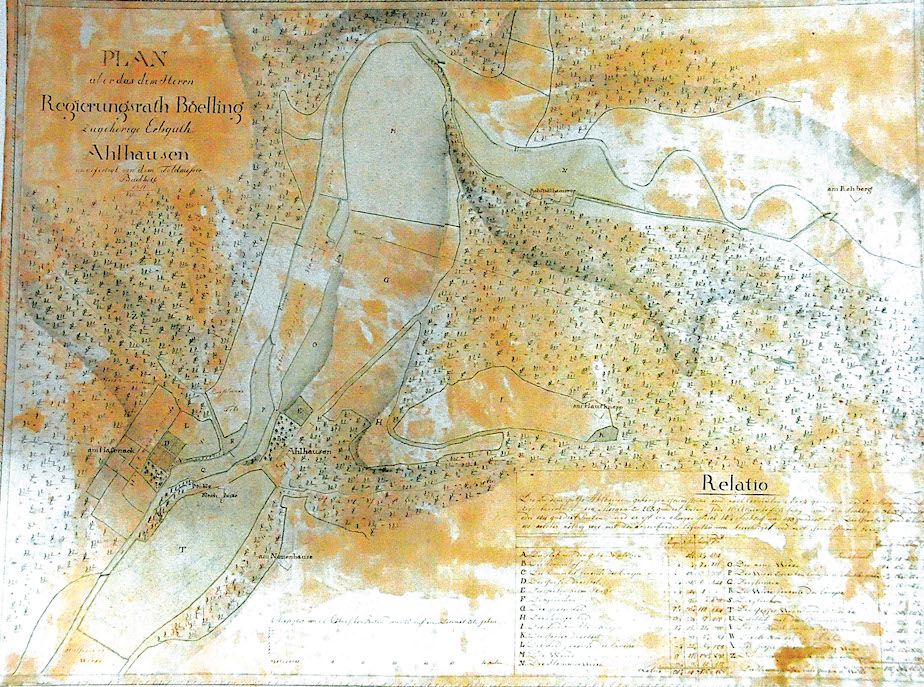History & cultural landscape
How now, over the many centuries, the building ensemble and the settlements on Ahlhausen, including the land, came into the hands of the von Ahlhausen family to such an extent that they, as owners, were also able to sell everything to the Gografen of the region Moritz Bölling - a feudal deed of the Benedictine imperial abbey Werden is at least next to the many notarizing lifting registers not known to this day - will have to be researched further. However, it can be regarded as certain that between 1592 and 1678 the von Ahlhausens themselves were the builders of the buildings and that the "anno 1678" carved into the sandstone of the old forge, with the insignia of Heinrich Wilhelm von Ahlhausen and Maria Magdalena von Ahlhausen nee Frowein, names exactly the spouses who then converted the rooms of the old fortifications from the Middle Ages, which were still arranged in the Renaissance style, into the early Baroque country palace as it stands today. Besides the well-known builders, the architects have not yet been discovered. But precisely the close ecclesiastical ties to the von Plettenbergs, a ministerial noble family in the county of Mark, which is very comparable to the ministerial noble family of the von Reuschenbergs in the county of Berg, indicate a trace on which the architects of the early baroque building activities at Schloss Ahlhausen to be found in the environment of the Capuchin Father Ambrosius von Oelde (1635/37 – 1705). From 1688 to 1706, Friedrich Christian von Plettenberg (1644 – 1706) was Prince Bishop of Münster, Ferdinand von Plettenberg (1690 – 1737) was “Prime Minister” under the Archbishop of Cologne and Elector Clemens August I of Bavaria, so that his auxiliary bishop and later vicar in the prince bishopric Münster, Johann Wilhelm d'Alhaus, from his birthplace on Ahlhausen will have breathed and noticed that early baroque spirit, as Ambrosius von Oelde used it in such a special and varied way for the prince-bishops of Münster and other builders in the monasteries, country palaces and representative town houses of Westphalia cast.
So stop off today at Schloss Ahlhausen with bed and breakfast and feel this history and cultural landscape in the spirit of the early baroque and in the simply simple wave swing of the "Karnie" for a few days completely decelerated in order to arrive in a country full of walnut, apple and Quince trees, in meadows by the water of the floodplains and in pastures, which next to you then only belong to the grazing Ahlhausen countryside sheep...
The oldest part of Milspe-Mühlinghausen is the noble estate of Ahlhausen, which was already heading towards Werden-Ruhr in the 12th century, where the first raw steel hammer in the district was probably made (again?) before 1670... In 1486 the Mesmeker to Wyllynkhusen was a wealthy knifemaker! – a specialist and small blacksmith!... Whereas in 1634 only 2 smet (blacksmiths) lived on the Mühlinghausen plateau; while the blast furnaces (melting works) in Ahlhausen... and some other lost engines had ceased operation as a result of the turmoil of war; since 1668 the pre-Christian, native 'Schmelterie' had reawakened in its old center in Mühlinghausen, since 1736 countless small smiths had taken the place of older iron smelters and hand forges... After 1736 a grinding cottage in Milspe was used, in which 'the hackers to the grinded in a flour mill (to cut the grooves in the millstones), to the manufacture of ice skates. Grinding huts for agricultural cutting tools (scythes and straw knives) are perhaps even older water works than the smelters of 1500 and the water hammers of 1600? Then soon followed numerous stretching and anvil hammers, steel refineries, 1790 the first rolling mill for sheet-like steel to carriage springs. Today's most important industry in Ennepethal already had machines driven by the stream in 1789, which cut screws (and the associated rollers for flattening the lint, i.e. linen ribbon) with such force that steel chips 7 mm thick fell off... (also) unfolded... (see above to be read at a bleaching hut until 1887...) through diligence... 'the strongest yarn business in the whole area'... which 'also occupied many other bleaching works in the Schwelm High Court'." (Ludorff, A.: Die Bau- und Kunstdenkmäler von Westfalen (Kreis Schwelm) (hg. v. Provinzial-Verband der Provinz Westfalen). Münster 1910., 18, 19)



